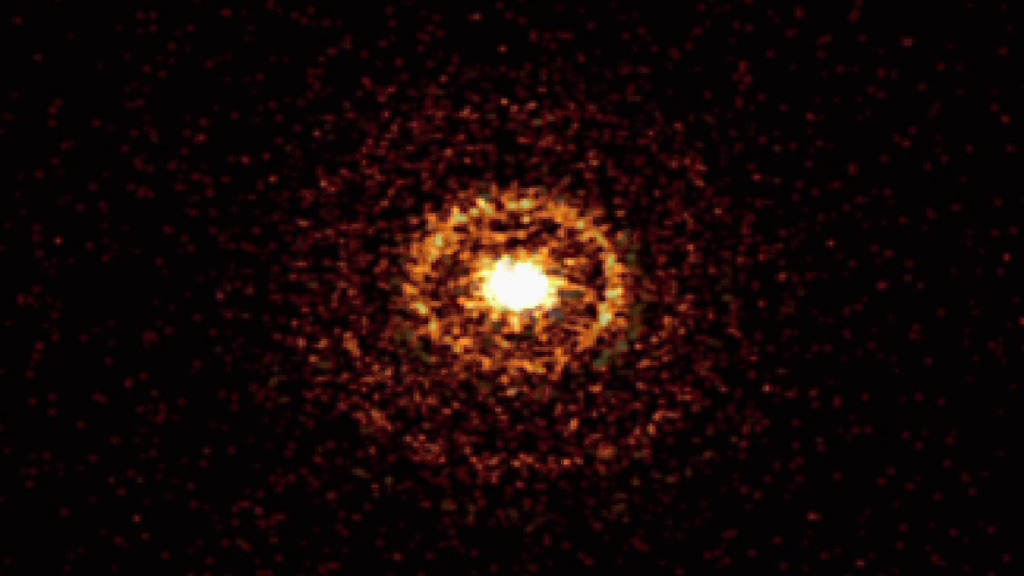NASA Missions Team Up to Study Unique Magnetar Outburst
On April 28, space- and ground-based observatories detected powerful, simultaneous X-ray and radio bursts from a source in our galaxy. Watch to see how this unique event helps solve the longstanding puzzle of fast radio bursts observed in other galaxies.
Credit: NASA's Goddard Space Flight Center
Music: "Jupiter's Eye" from Universal Production Music
Watch this video on the NASA Goddard YouTube channel.
Complete transcript available.
On April 28, a supermagnetized stellar remnant known as a magnetar blasted out a simultaneous mix of X-ray and radio signals never observed before. The flare-up included the first fast radio burst (FRB) ever seen from within our Milky Way galaxy and shows that magnetars can produce these mysterious and powerful radio blasts previously only seen in other galaxies.
A magnetar is a type of isolated neutron star, the crushed, city-size remains of a star many times more massive than our Sun. What makes a magnetar so special is its intense magnetic field. The field can be 10 trillion times stronger than a refrigerator magnet's and up to a thousand times stronger than a typical neutron star's. This represents an enormous storehouse of energy that astronomers suspect powers magnetar outbursts.
The X-ray portion of the synchronous bursts was detected by several satellites, including NASA's Wind mission.
The radio component was discovered by the Canadian Hydrogen Intensity Mapping Experiment (CHIME), a radio telescope located at Dominion Radio Astrophysical Observatory in British Columbia and led by several Canadian universities. It was also detected by the NASA-funded Survey for Transient Astronomical Radio Emission 2 (STARE2), a trio of detectors in California and Utah operated by Caltech and NASA’s Jet Propulsion Laboratory in Southern California. The STARE2 data showed that the burst's energy was comparable to FRBs.
By the time these bursts occurred, astronomers had already been monitoring their source, a magnetar named SGR 1935+2154, for more than half a day using NASA's Neil Gehrels Swift Observatory, Fermi Gamma-ray Space Telescope, and the Neutron star Interior Composition Explorer (NICER) X-ray telescope mounted atop the International Space Station.
About 13 hours later, when the magnetar was out of view for Swift, Fermi and NICER, a special X-ray burst erupted. The blast was seen by the European Space Agency’s INTEGRAL mission, the China National Space Administration’s Huiyan X-ray satellite, and the Russian Konus instrument on Wind. As the half-second-long X-ray burst flared, CHIME and STARE2 detected the radio burst, which lasted only a thousandth of a second.
Taken together, the observations strongly suggest that the magnetar produced the Milky Way galaxy's equivalent of an FRB, which means magnetars in other galaxies likely produce at least some of these signals.
Illustrated wide shot showing an X-ray burst ejecting a plume of material that travels high above the magnetar and emits a radio burst. Radio signals from pulsars, another class of neutron star, originate high above their surfaces – exactly where and how, we don’t know. Astronomers think the X-ray burst from SGR 1935 ejected a plume of matter that soared to similar heights, where it emitted the powerful radio burst.
Credit: NASAs Goddard Space Flight Center/Chris Smith (USRA)
Illustrated medium view of a magnetar during a burst storm. Late on April 27, NASA’s Neil Gehrels Swift Observatory spotted a new round of activity from magnetar SGR 1935+2154, located in the constellation Vulpecula. It was the object’s most prolific flare-up yet – a storm of rapid-fire X-ray bursts, each lasting less than a second. The storm raged for hours, picked up at various times by Swift, NASA’s Fermi Gamma-ray Space Telescope, and NASA’s Neutron star Interior Composition Explorer (NICER) X-ray telescope on the International Space Station.
Credit: NASAs Goddard Space Flight Center/Chris Smith (USRA)
A powerful X-ray burst erupts from magnetar SGR 1935+2154 in this illustration. The April 28 eruption, which lasted about half a second, likely drove off a plume of matter. Astronomers say that, while the X-ray burst flared, the ejected material emitted a radio burst lasting just a thousandth of a second, likely from a location high above the magnetar.
Credit: NASA’s Goddard Space Flight Center/Chris Smith (USRA)
Illustrated magnetar flyby sequence showing magnetic field lines. A magnetar is a type of isolated neutron star, the crushed, city-size remains of a star many times more massive than our Sun. Their magnetic fields can be 10 trillion times stronger than a refrigerator magnet's and up to a thousand times stronger than a typical neutron star's. This represents an enormous storehouse of energy that astronomers suspect powers magnetar outbursts.
Credit: NASAs Goddard Space Flight Center/Chris Smith (USRA)
Illustrated magnetar flyby sequence during which magnetic field lines appear.
Credit: NASAs Goddard Space Flight Center/Chris Smith (USRA)

A powerful X-ray burst erupts from a magnetar – a supermagnetized version of a stellar remnant known as a neutron star – in this illustration. A radio burst detected April 28 occurred during a flare-up like this on a magnetar called SGR 1935. The radio signal was more powerful than any previously seen in our galaxy. The simultaneous X-ray and radio events implicate magnetars as a likely source of mysterious fast radio bursts observed from other galaxies.
Credit: NASA’s Goddard Space Flight Center/Chris Smith (USRA)
For More Information
Credits
Please give credit for this item to:
NASA's Goddard Space Flight Center. However, individual items should be credited as indicated above.
-
Producers
- Scott Wiessinger (USRA)
- Chris Smith (USRA)
-
Animators
- Chris Smith (USRA)
- Scott Wiessinger (USRA)
-
Science writer
- Francis Reddy (University of Maryland College Park)
-
Narrator
- Scott Wiessinger (USRA)
-
Editor
- Scott Wiessinger (USRA)
-
Scientist
- Zaven Arzoumanian (NASA/GSFC)
Release date
This page was originally published on Wednesday, November 4, 2020.
This page was last updated on Wednesday, May 3, 2023 at 1:44 PM EDT.
Missions
This page is related to the following missions:Series
This page can be found in the following series:Related papers
https://www.nature.com/articles/s41586-020-2863-y; https://www.nature.com/articles/s41586-020-2872-x
https://www.nature.com/articles/s41586-020-2863-y; https://www.nature.com/articles/s41586-020-2872-x





